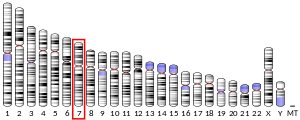
AGR2

2LNS, 2LNT1055123795ENSG00000106541ENSMUSG00000020581O95994O88312NM_006408NM_011783NP_006399NP_035913Anterior gradient protein 2 homolog (AGR-2), also known as secreted cement gland protein XAG-2 homolog, is a protein that in humans is encoded by the AGR2 gene. Anterior gradient homolog 2 was originally discovered in Xenopus laevis. In Xenopus AGR2 plays a role in cement gland differentiation, but in human cancer cell lines high levels of AGR2 correlate with downregulation of the p53 response, cell migration, and cell transformation. However, there have been other observations that AGR2 can repress growth and proliferation. Anterior gradient protein 2 homolog (AGR-2), also known as secreted cement gland protein XAG-2 homolog, is a protein that in humans is encoded by the AGR2 gene. Anterior gradient homolog 2 was originally discovered in Xenopus laevis. In Xenopus AGR2 plays a role in cement gland differentiation, but in human cancer cell lines high levels of AGR2 correlate with downregulation of the p53 response, cell migration, and cell transformation. However, there have been other observations that AGR2 can repress growth and proliferation. The Xenopus laevis anterior gradient genes - XAG-1, XAG-2, and XAG-3 - were discovered through dissection of different-aged embryos. They become expressed in the anterior region of the dorsal ectoderm in late gastrula embryos. XAG-2 expression gathers at the anterior region of the dorsal ectoderm, and this region corresponds to the cement gland anlage. Many other homologous proteins have been discovered afterwards in Xenopus. AGR2 is the human homolog of XAG-2. It is expressed strongly in tissues that secrete mucus or function as endocrine organs, including the lungs, stomach, colon, prostate and small intestine. Its protein expression has been shown to be regulated by both androgens and estrogens. AGR2 is a protein disulfide isomerase, with a single CXXS active domain motif for oxidation and reduction reactions. AGR2 forms mixed disulfides in substrates, such as intestinal mucin. AGR2 interacts with Mucin 2 through its thioredoxin-like domain forming a heterodisulfide bond with cysteine residues in MUC2. AGR2 is suggested to play a role in protein folding, and it has a KTEL C-terminal motif similar to KDEL and KVEL endoplasmic reticulum retention sequences. Agr2 is located on chromosome 7p21, a region that has frequent genetic alterations. It was first identified in estrogen receptor-positive breast cancer cells. Later studies showed elevated levels of AGR2 in adenocarcinomas of the esophagus, pancreas, and prostate. In Barrett's esophagus, Agr2 expression is elevated by over 70 times compared to normal esophageal epithelia. Thus, this protein alone is enough to distinguish Barrett's esophagus, which is linked to esophageal adenocarcinoma, from a normal esophagus. Varying AGR2 levels exist in different cancers. In breast cancer, high AGR2 expression is correlated with low survival rate. AGR2 levels are elevated in the preneoplastic tissue Barrett's oesophagus. AGR2 is also associated with prostate cancer, though lower levels are associated with higher Gleason grades. In contrast to upregulation of AGR2 in various cancers, downregulation of AGR2 is linked with inflammatory bowel disease and increases in the risk of Crohn's disease and ulcerative colitis. This implies the importance of AGR2 in maintaining epithelial barrier function, which is supported by FOXA1 and FOXA2 molecules (transcription factors for epithelial goblet cells) which can activate the AGR2 promoter. In breast cancer, AGR2 and estrogen (ER) expression are positively correlated. Approximately 70% of breast cancer patients have breast cancer cells that heavily express ER and progesterone receptors (PgR). These patients are normally treated with endocrine therapy. Tamoxifen, which blocks the binding of estradiol to its receptor, is the standard treatment for ER-positive breast cancer. However, about one third of patients do not respond to this therapy, and increased AGR2 may be one reason. There is a positive correlation for a higher level of AGR2 expression with poor therapeutic results in ERα-positive breast cancer patients. Agr2 mRNA expression is elevated in in vitro and in vivo studies responding to tamoxifen adjuvant therapy, so AGR2 is likely provides an agonistic effect on tamoxifen. Therefore, AGR2 is a possible predictive biomarker when selecting patients with ER-positive breast cancer to participate this therapy. Although Agr2 mRNA levels are correlated with the tamoxifen therapy response, AGR2 protein levels have yet to be statistically associated with the therapy. A combinatorial therapy using the anastrozole and fulvestrant has been shown to prevent binding of the ER to the Agr2 promoter, and there has been improved prognosis in the patients receiving it, possibly because AGR2 expression in the tumors have been reduced.
